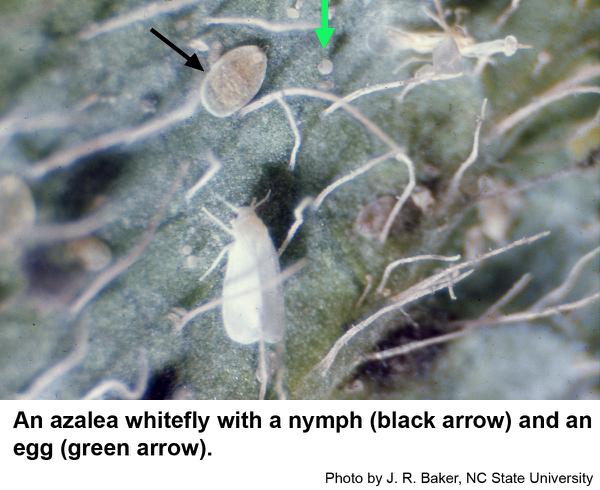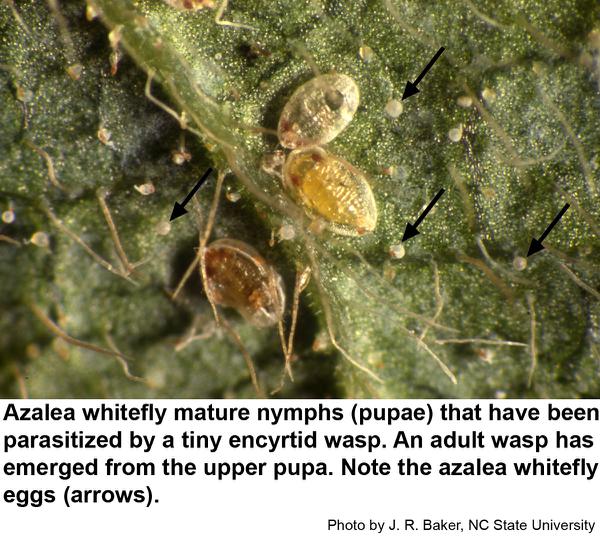Description and Biology
Azalea whiteflies, Pealius azaleae, are tiny, snow-white insects that resemble tiny, snow-white moths about 1/16 inch long. Females insert their eggs just into the lower surface of azalea leaves. From the eggs hatch minute, yellowish crawlers that resemble motile pollen grains. Eventually the crawlers insert their threadlike mouthparts into the leaf and begin to suck sap. Crawlers molt into pale, scale-like insects called nymphs that also suck sap. Mature nymphs are light yellow to orange. Crawlers and nymphs as well as adults excrete honeydew, a clear sweet liquid. Fungi called sooty molds grow in the honeydew and cause infested azaleas to become dark - sometimes almost black! Sooty molds may damage the shrub by literally blocking sunlight from the leaves and shading the plant out.
Host Plants
Azalea whiteflies infest all cultivars of azaleas. Infested plants become unthrifty, and honeydew and sooty molds further detract from a healthy appearance. Clouds of adults may fly up whenever heavily infested plants are disturbed.
Residential Recommendations
For control of azalea whiteflies, one of the horticultural oils should be moderately effective as well as helping to weather away sooty molds clinging to the shrubs long after the whiteflies are gone. One thorough treatment in the fall and another in the spring after new growth emerges should greatly reduce azalea whiteflies although infested shrubs can be treated any time that the whiteflies are first noted (except when azaleas have brand new, tender foliage. This warning also applies to soaps, pyrethroids, and imidacloprid—insecticides also labeled for whitefly control in residential landscapes.). When used as directed, pyrethroids are very toxic to insects but are not particularly hazardous to humans and pets (other than fish-avoid using pyrethroids around pools, ponds, and streams).
References
- Insect and related Pests of Flowers and Foliage Plants. Baker, J. R., ed. 1994. NC Coop. Extension Service Pub. AG-136. 106 pp.
- Sooty Molds. Frank, S. D., S. B. Bambara and R. K. Jones. 2002 revised. Entomology Insect Notes, NC State Extension Publications.
- Extension Plant Pathology Publications and Factsheets
- Horticultural Science Publications
- North Carolina Agricultural Chemicals Manual
For assistance with a specific problem, contact your local Cooperative Extension Center
This Factsheet has not been peer reviewed.
Publication date: Dec. 19, 2017
Reviewed/Revised: June 15, 2021
Recommendations for the use of agricultural chemicals are included in this publication as a convenience to the reader. The use of brand names and any mention or listing of commercial products or services in this publication does not imply endorsement by NC State University or N.C. A&T State University nor discrimination against similar products or services not mentioned. Individuals who use agricultural chemicals are responsible for ensuring that the intended use complies with current regulations and conforms to the product label. Be sure to obtain current information about usage regulations and examine a current product label before applying any chemical. For assistance, contact your local N.C. Cooperative Extension county center.
N.C. Cooperative Extension prohibits discrimination and harassment regardless of age, color, disability, family and marital status, gender identity, national origin, political beliefs, race, religion, sex (including pregnancy), sexual orientation and veteran status.



